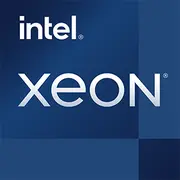Intel Xeon E-2186M

Intel Xeon E-2186M: Power for Professionals in a Mobile Format
Relevance in 2025: Is this Processor Worth Considering?
Architecture and Process: Coffee Lake in Detail
The Intel Xeon E-2186M processor, released in 2018, is based on the Coffee Lake architecture and a 14nm manufacturing process. Despite its age, it remains in demand in the mobile workstation segment due to its reliability and specific features.
- 6 cores, 12 threads: Hyper-Threading enables efficient task distribution. Base frequency is 2.9 GHz, with a maximum turbo frequency of 4.8 GHz (single-core) or 4.3 GHz (all cores).
- Integrated Intel UHD P630 graphics: 24 Execution Units (EUs), frequencies of up to 1.2 GHz. Supports 4K@60Hz via DisplayPort, hardware decoding of HEVC and VP9. Optimizations for CAD applications are enabled for professional use.
Xeon Feature: Support for ECC memory, critical for workstations where data errors are unacceptable (e.g., engineering calculations).
Power Consumption and TDP: Balancing Power and Heat
The processor's TDP is 45W, but under peak loads (e.g., rendering), consumption can reach 80–90W. This requires an advanced cooling system.
- Thermal Limitations: In thin laptops (e.g., Dell Precision 5530), the processor often throttles (reduces frequencies) during prolonged workloads. In bulkier models (HP ZBook 17 G5), thermal performance is more stable.
- Energy Efficiency: By 2025 standards, the 14nm process lags behind modern 5nm (Apple M3) or 4nm (AMD Zen 4) chips in terms of power consumption per watt.
Performance: Real-World Tasks and Turbo Mode
Geekbench 6:
- Single-Core: 1310 (comparable to Ryzen 5 5600H);
- Multi-Core: 5116 (close to Core i7-11800H).
Use Cases:
1. Office Work: In Microsoft Office, with a browser holding 50+ tabs, the processor operates smoothly.
2. Multimedia:
- 4K video encoding in HandBrake: 6-core rendering is 30% faster than that of the 4-core Core i7-8750H.
- Working in Adobe Premiere: Smooth editing when using a discrete GPU (Nvidia Quadro).
3. Gaming:
- Integrated P630 graphics: Only light projects (CS:GO — 40–50 FPS on low settings).
- With a discrete graphics card (Nvidia RTX 3000/4000): Current games on high settings (Cyberpunk 2077 — 60+ FPS at FHD).
Turbo Boost: In short tasks (application launches, code compilation), the frequency can rise to 4.8 GHz, but under sustained loads (over 5 minutes), it stabilizes at 3.8–4.0 GHz.
Use Cases: Who is the E-2186M Suitable For?
- Engineers and Designers: SolidWorks, AutoCAD, Revit with ECC memory support.
- Data Analysts: Handling large datasets in Excel, Python.
- Creative Professionals: Video editing, 3D rendering (in conjunction with a discrete GPU).
- Gamers: Only in combination with a powerful graphics card.
Not Suitable For:
- Users who require over 6 hours of battery life.
- Those seeking ultraportable devices (thickness typically starts from 20mm).
Battery Life: The Cost of Performance
With a TDP of 45W, battery life for office tasks is around 4–6 hours (e.g., Dell Precision 7530 with a 97Wh battery).
Power-Saving Technologies:
- Intel Speed Shift: Dynamic frequency adjustments to reduce latency.
- C-States: Disabling unused cores.
Advice: To extend battery life, choose the "Power Saver" mode in power settings and limit processor frequency to 2.5 GHz.
Comparison with Competitors
1. AMD Ryzen 9 6900HX (2022):
- 8 cores/16 threads, 6nm, TDP 45W.
- Better multi-core performance (+25% in Cinebench R23), but lacks ECC memory.
2. Apple M2 Pro (2023):
- 10–12 cores, 5nm, TDP 30W.
- Up to 18 hours of battery life, but limited compatibility with Windows applications.
3. Intel Core i9-11980HK (2021):
- 8 cores/16 threads, 14nm, TDP 65W.
- Higher performance in gaming, but generates more heat.
Prices: Laptops with the Xeon E-2186M in 2025 are from $1500 (used from $700). New devices are rare, mainly leftover stock.
Pros and Cons
Strengths:
- ECC memory support for enhanced reliability.
- Stable operation under prolonged loads.
- Compatibility with professional software (ISV certification).
Weaknesses:
- High power consumption by modern standards.
- Lack of PCIe 4.0 (only PCIe 3.0).
- Price: New devices are more expensive than Ryzen 5/7 equivalents.
Recommendations for Choosing a Laptop
- Device Type: Workstation (Dell Precision, HP ZBook) or gaming laptop (rare, e.g., MSI WS Series).
- What to Pay Attention to:
- Cooling system: At least two fans, copper heat pipes.
- Upgrade options: 2 DDR4 slots, 2 NVMe drives.
- Screen: For professional tasks — 4K with 100% sRGB coverage.
Examples of Models in 2025:
- Dell Precision 5580 (2024): Xeon E-2186M, 32GB DDR4 ECC, Quadro RTX 3000 — from $2200.
- HP ZBook Fury 17 G8: Similar configuration — from $2400.
Final Conclusion: Who is the Xeon E-2186M Suitable For?
This processor is a good choice if you:
- Work with professional software that requires ECC memory.
- Need a mobile workstation with guaranteed reliability.
- Are not ready to transition to ARM architecture (Apple Silicon) due to compatibility issues.
Alternatives for 2025:
- For battery life — Apple M3/M4.
- For multi-threaded tasks — AMD Ryzen 9 8945HS.
- For gaming — Intel Core i7-14700HX.
Key Benefit of the E-2186M: An ideal balance for professionals where stability and compatibility are more important than the latest technologies.
Basic
CPU Specifications
Memory Specifications
GPU Specifications
Miscellaneous
Benchmarks
Compared to Other CPU
Share in social media
Or Link To Us
<a href="https://cputronic.com/index.php/cpu/intel-xeon-e-2186m" target="_blank">Intel Xeon E-2186M</a>